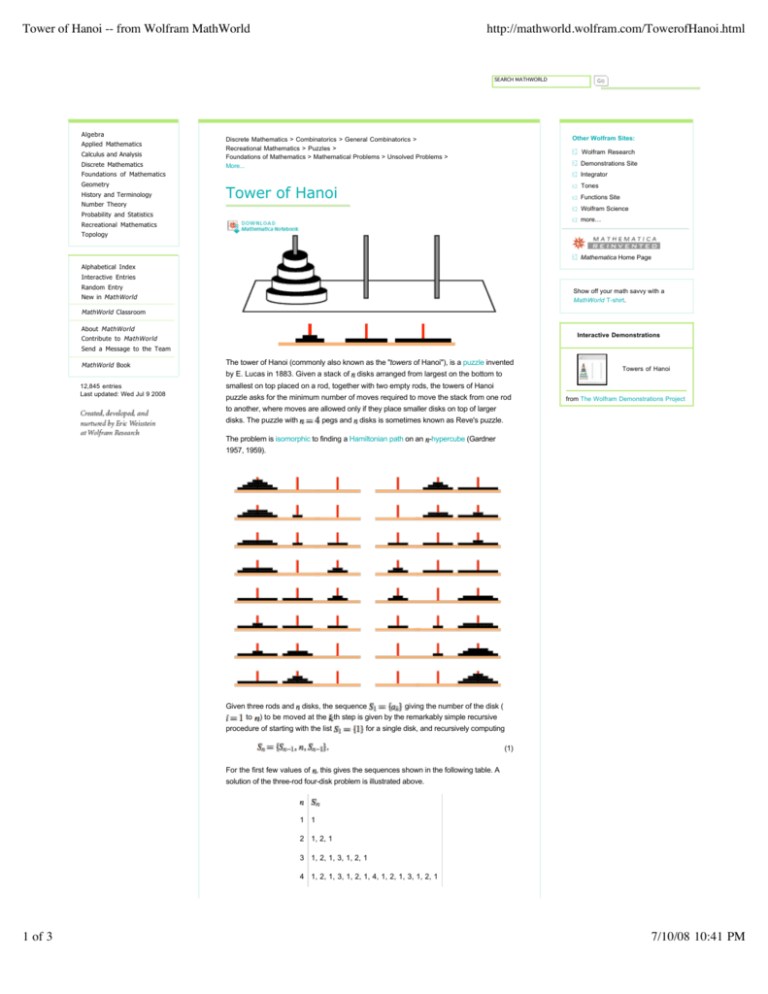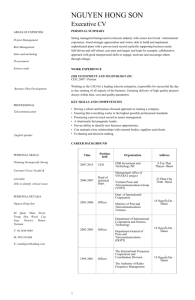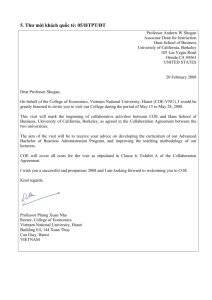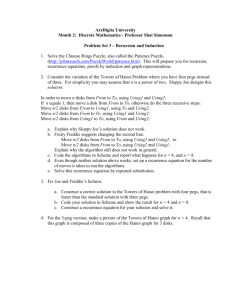Tower of Hanoi -- from Wolfram MathWorld
advertisement

Tower of Hanoi -- from Wolfram MathWorld http://mathworld.wolfram.com/TowerofHanoi.html SEARCH MATHWORLD Algebra Applied Mathematics Calculus and Analysis Discrete Mathematics Other Wolfram Sites: Discrete Mathematics > Combinatorics > General Combinatorics > Recreational Mathematics > Puzzles > Foundations of Mathematics > Mathematical Problems > Unsolved Problems > More... Wolfram Research Demonstrations Site Foundations of Mathematics Geometry History and Terminology Number Theory Integrator Tones Tower of Hanoi Functions Site Wolfram Science Probability and Statistics more… Recreational Mathematics Topology Mathematica Home Page Alphabetical Index Interactive Entries Random Entry Show off your math savvy with a MathWorld T-shirt. New in MathWorld MathWorld Classroom About MathWorld Interactive Demonstrations Contribute to MathWorld Send a Message to the Team MathWorld Book The tower of Hanoi (commonly also known as the "towers of Hanoi"), is a puzzle invented by E. Lucas in 1883. Given a stack of disks arranged from largest on the bottom to 12,845 entries Last updated: Wed Jul 9 2008 smallest on top placed on a rod, together with two empty rods, the towers of Hanoi puzzle asks for the minimum number of moves required to move the stack from one rod to another, where moves are allowed only if they place smaller disks on top of larger disks. The puzzle with pegs and disks is sometimes known as Reve's puzzle. Towers of Hanoi from The Wolfram Demonstrations Project The problem is isomorphic to finding a Hamiltonian path on an -hypercube (Gardner 1957, 1959). Given three rods and disks, the sequence giving the number of the disk ( to ) to be moved at the th step is given by the remarkably simple recursive procedure of starting with the list for a single disk, and recursively computing (1) For the first few values of , this gives the sequences shown in the following table. A solution of the three-rod four-disk problem is illustrated above. 1 1 2 1, 2, 1 3 1, 2, 1, 3, 1, 2, 1 4 1, 2, 1, 3, 1, 2, 1, 4, 1, 2, 1, 3, 1, 2, 1 1 of 3 7/10/08 10:41 PM Tower of Hanoi -- from Wolfram MathWorld http://mathworld.wolfram.com/TowerofHanoi.html As the number of disks is increases (again for three rods), an infinite sequence is obtained, the first few terms of which are illustrated in the table above (Sloane's A001511). Amazingly, this is exactly the binary carry sequence plus one. Even more amazingly, the number of disks moved after the th step is the same as the element which needs to be added or deleted in the th addend of the Ryser formula (Gardner 1988, Vardi 1991). A simple method for hand-solving uses disks painted with alternating colors. No two disks of the same color are ever placed atop each other, and no disk is moved twice in a row (P. Tokarczuk, pers. comm. Jun. 23, 2004). As a result of the above procedure, the number of moves of disks on three rods is given by the recurrence relation required to solve the puzzle (2) with . Solving gives (3) i.e., the Mersenne numbers. For three rods, the proof that the above solution is minimal can be achieved using the Lucas correspondence which relates Pascal's triangle to the Hanoi graph. While algorithms are known for transferring disks on four rods, none has been proved minimal. A Hanoi graph can be constructed whose graph vertices correspond to legal configurations of towers of Hanoi, where the graph vertices are adjacent if the corresponding configurations can be obtained by a legal move. The puzzle itself can be solved using a binary Gray code. Poole (1994) and Rangel-Mondragón give Mathematica routines for solving the Hanoi towers problem. Poole's algorithm works for an arbitrary disk configuration, and provides the solution in the fewest possible moves. The minimal numbers of moves required to order , 2, ... disk on four rods are given by 1, 3, 5, 9, 13, 17, 25, 33, ... (Sloane's A007664). It is conjectured that this sequence is given by the recurrence (4) with and the positive floor integer solution to (5) i.e., (6) This would then given the explicit formula (7) SEE ALSO: Binary Carry Sequence, Gray Code, Pancake Sorting, Puz-Graph, Ryser Formula REFERENCES: Allouche, J.-P. and Shallit, J. "The Ring of -Regular Sequences." Theoret. Comput. Sci. 98, 163-197, 1992. Allouche, J.-P. "Note on the Cyclic Towers of Hanoi." Theor. Comput. Sci. 123, 3-7, 1994. Bogomolny, A. "Towers of Hanoi." http://www.cut-the-knot.org/recurrence/hanoi.shtml. Brousseau, A. "Tower of Hanoi with More Pegs." J. Recr. Math. 8, 169-176, 1972. Chartrand, G. "The Tower of Hanoi Puzzle." §6.3 in Introductory Graph Theory. New York: Dover, pp. 135-139, 1985. Daiev, V. "Problem 636: Greatest Divisors of Even Integers." Math. Mag. 40, 164-165, 1967. Dubrovsky, V. "Nesting Puzzles, Part I: Moving Oriental Towers." Quantum 6, 53-57 (Jan.) and 49-51 (Feb.), 1996. Flajolet, P.; Raoult, J.-C.; and Vuillemin, J. "The Number of Registers Required for Evaluating Arithmetic Expressions." Theoret. Comput. Sci. 9, 99-125, 1979. Frame, J. S. "Solution to Problem 3918." Amer. Math. Monthly 41, 216-217, 1941. Gardner, M. "Mathematical Games: About the Remarkable Similarity between the Icosian Game and 2 of 3 7/10/08 10:41 PM Tower of Hanoi -- from Wolfram MathWorld http://mathworld.wolfram.com/TowerofHanoi.html the Towers of Hanoi." Sci. Amer. 196, 150-156, May 1957. Gardner, M. "The Icosian Game and the Tower of Hanoi." Ch. 6 in Hexaflexagons and Other Mathematical Diversions: The First Scientific American Book of Puzzles and Games. New York: Simon and Schuster, pp. 55-62, 1959. Kai, Y. and Chuan, X. "Preliminary Probe of 4-Peg Hanoi Tower." Acta Scient. Natur. Univers. Pekin. 40, 99-106, 2004. Kasner, E. and Newman, J. R. Mathematics and the Imagination. Redmond, WA: Tempus Books, pp. 169-171, 1989. Kolar, M. "Tower of Hanoi (TH) Puzzle." http://HanoiTower.mkolar.org/. Kraitchik, M. "The Tower of Hanoi." §3.12.4 in Mathematical Recreations. New York: W. W. Norton, pp. 91-93, 1942. Lucas, É. Récréations mathématiques, Vol. 3. Paris: Gauthier-Villars, 1891-1894. Reprinted Albert Blanchard, 1960. Poole, D. G. "The Towers and Triangles of Professor Claus (or, Pascal Knows Hanoi)." Math. Mag. 67, 323-344, 1994. Poole, D. G. "Towers of Hanoi Package." http://mathworld.wolfram.com/packages/Hanoi.m. Rangel-Mondragón, J. "Generalized Hanoi Tower." http://library.wolfram.com/infocenter/MathSource/4861/. Ruskey, F. "Towers of Hanoi." http://www.theory.csc.uvic.ca/~cos/inf/comb/SubsetInfo.html#Hanoi. Schoutte, P. H. "De Ringen van Brahma." Eigen Haard 22, 274-276, 1884. Sloane, N. J. A. Sequences A001511/M0127, A007664/M2449, and A007665/M2414 in "The On-Line Encyclopedia of Integer Sequences." Stewart, B. M. "Problem 3918." Amer. Math. Monthly 39, 363, 1939. Stewart, B. M. "Solution to Problem 3918." Amer. Math. Monthly 41, 216-219, 1941. Vardi, I. Computational Recreations in Mathematica. Reading, MA: Addison-Wesley, pp. 111-112, 1991. Wood, D. "Towers of Brahma and Hanoi Revisited." J. Recr. Math. 14, 17-24, 1981. CITE THIS AS: Weisstein, Eric W. "Tower of Hanoi." From MathWorld--A Wolfram Web Resource. http://mathworld.wolfram.com/TowerofHanoi.html Contact the MathWorld Team © 1999-2008 Wolfram Research, Inc. | Terms of Use 3 of 3 7/10/08 10:41 PM








